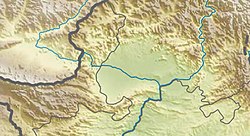 Ranigat was built on a mountaintop overlooking the Valley of Peshawar | |
| Location | Buner Khyber Pakhtunkhwa Pakistan |
|---|---|
| Coordinates | 34°13′50″N 72°26′56″E / 34.2306°N 72.4488°E |
| History | |
| Founded | 2nd century CE |
| Abandoned | 6th century |
| Periods | Gandhara |
| Site notes | |
| Archaeologists | Alexander Cunningham Henry Walter Bellew |
| Official name | Archaeological Site of Ranigat |
| Type | Tentative listing |
| Criteria | ii, iv |
| Reference no. | 1879 |
Ranigat (Pashto: راني ګټ) is a collection of 2nd-century CE Buddhist ruins spread over an area of 4 km2 (1.5 sq mi) that dates from the Gandhara civilization. Ranigat is located in the Buner Valley of Pakistan's Khyber Pakhtunkhwa province.
According to archeologists, Ranigat remained the center of Buddhist art and culture for centuries. Ranigat has been a celebrated part of folklore, with songs and stories written about it.[1]
Rani Gatt (lit. the queen of stones in Pashto) is a 2500-year-old Buddhist archaeological site belonging to the Gandahara civilization located in the Buner District of Khyber Pakhtunkhwa, Pakistan. Ranigat is a good example of the Buddhist past of the area. The site is located on top of a hill, accessible by climbing the stairs constructed by the Japanese. The main attractions include the Stupas, a big rock erected by the ancient people at some distance that they probably used to worship. The city or town was beautifully designed, and stones from the local mountains have been extensively used. Ranigat is easily accessible through the M1 and N35. It is about 20 km (12 mi) away from Swabi and 100 km (62 mi) from Peshawar and Islamabad.



